| Part of a series on the |
| Copts |
|---|
| Culture |
| Regions |
| Denominations |
|
|
| Part of a series on |
| Oriental Orthodoxy |
|---|
 |
| Oriental Orthodox churches |
|
|
Coptic monasticism was a movement in the Coptic Orthodox Church to create a holy, separate class of person from layman Christians.
It is said to be the original form of monasticism. as Anthony the Great became the first one to be called "monk" (Ancient Greek: μοναχός) and he was the first to establish a Christian monastery which is now known as the Monastery of Saint Anthony[1] at the base of Mount Colzim.
The Monastery of Saint Anthony is the oldest Christian monastery in the world. (It is not the oldest monastery because vihāras for Buddhist monasticism were established by 500 BCE, many hundreds of years earlier.[2]
Although Anthony's way of life was focused on solitarity, Pachomius the Great, a Copt from Upper Egypt, established cenobitic monasticism[1] in his monasteries in Upper Egypt, which laid the basic monastic structure for many of the monasteries today in many monastic orders even outside of Coptic Orthodoxy.
Origins
Institutional Christian monasticism seems to have begun in the deserts in fourth century Egypt as a kind of living martyrdom. Scholars such as Lester K. Little attribute the rise of monasticism at this time to the immense changes in the church that had been brought about by Constantine the Great's acceptance of Christianity as the main religion of the Roman Empire. This ended the position of Christians as a small group that believed itself to be the godly elite. In response a new more advanced form of dedication was developed to preserve a nucleus of the dedicated. The end of persecution also meant that martyrdom was no longer an option to prove one's piety. Instead the long-term "martyrdom" of the ascetic became common.
Many Egyptian Christians went to the desert during the third century, and remained there to pray and work and dedicate their lives to seclusion and worship of God. This was the beginning of the monastic movement, which was organized by Anthony, the world's first anchorite Macarius of Alexandria, and Pachomius in the fourth century.
Pachomius
Pachomius established his first monastery between 318 and 323 at Tabenna, Egypt, and when it grew too large, his second one, Pbow, was built in Fāw Qiblī. Pachomius spent most of his time at Pbow. By the time of his death in 345, one count estimates there were 3000 monasteries dotting Egypt from north to south. Within a generation after his death, this number grew to 7000 and then expanding out of Egypt into Palestine and the Judaean Desert, Syria, North Africa and eventually Western Europe.[3]
Monasticism
Christian monasticism was born in Egypt and was instrumental in the formation of the Coptic Orthodox Church character of submission, simplicity and humility, thanks to the teachings and writings of the Great Fathers of Egypt's Deserts. By the end of the 5th century, there were hundreds of monasteries, and thousands of cells and caves scattered throughout the Egyptian desert. A great number of these monasteries are still flourishing and have new vocations to this day.
All Christian monasticism stems, either directly or indirectly, from the Egyptian example: Saint Basil the Great Archbishop of Caesaria of Cappadocia, founder and organizer of the monastic movement in Asia Minor, visited Egypt around 357 AD and his rule is followed by the Eastern Orthodox Churches; Saint Jerome who translated the Bible into Latin, came to Egypt, while en route to Jerusalem, around 400 AD and left details of his experiences in his letters; Benedict founded the Benedictine Order in the 6th century on the model of Saint Pachomius, but in a stricter form. Countless pilgrims have visited the "Desert Fathers" to emulate their spiritual, disciplined lives.
The Coptic monasticism took three forms:[4]
- Monachism
- The coenobitic system
- The communal System or semi-eremitic Life
Modern status
The Coptic Orthodox Church has many monasteries and convents that host many monks and nuns. All of the Coptic bishops are chosen from monks, although this was not necessary traditionally.
Coptic monasticism saw a revival that started in the 1960s during the papacy of Pope Cyril VI of Alexandria,[5] and currently there are Coptic monasteries and convents in Egypt, the United States, Australia and Europe that have been recognized by the Holy Synod of the Coptic Orthodox Church.[6]
There are currently 33 monasteries in Egypt and in the lands of the immigration with a total of more than 1,000 monks, and six convents with about 300 nuns.[7] The largest monasteries, and most famous, are at Wadi Natrun,[8] about 60 miles northwest of Cairo. They are the only four of the ancient fortified self-sufficient monasteries which have survived out of many that were in the Wadi Natroun valley.
Image gallery
- Coptic monasteries

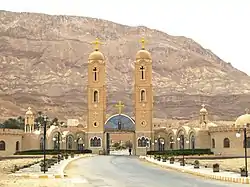

 Coptic Monastery in Scetes, Egypt
Coptic Monastery in Scetes, Egypt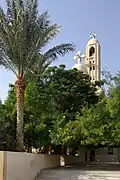 Monastery of Saint Pishoy, Scetes, Egypt
Monastery of Saint Pishoy, Scetes, Egypt Monastery of Saint Pishoy, Scetes, Egypt
Monastery of Saint Pishoy, Scetes, Egypt Monastery of Saint Pishoy, Scetes, Egypt
Monastery of Saint Pishoy, Scetes, Egypt

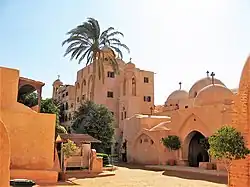 Syrian Monastery, Scetes, Egypt
Syrian Monastery, Scetes, Egypt.jpg.webp)
 Monastery of Saint Anthony, Kröffelbach, Germany
Monastery of Saint Anthony, Kröffelbach, Germany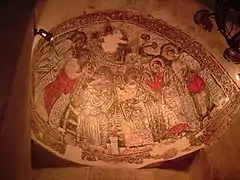 Frescos at the Syrian Monastery, Scetes, Egypt
Frescos at the Syrian Monastery, Scetes, Egypt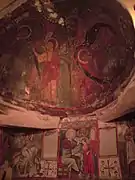 Frescos at the Syrian Monastery, Scetes, Egypt
Frescos at the Syrian Monastery, Scetes, Egypt
See also
References
- 1 2 "Monasticism in Egypt by Pope Shenouda". Archived from the original on 2009-10-22. Retrieved 2009-10-25.
- ↑ Winters, Dennis A. (1988). "The First Buddhist Monasteries". The Tibet Journal. 13 (2): 12–22. Retrieved 10 January 2021.
- ↑ Kenneth W. Harl (2001), The World of Byzantium, ISBN 1-56585-090-4 (audio recording)
- ↑ Coptic centre Archived 2007-07-12 at the Wayback Machine
- ↑ "Religion: The Desert Revival". Time. April 19, 1976. Archived from the original on March 14, 2011.
- ↑ St Takla.org Coptic Monasteries & Convents Links
- ↑ CNEWA
- ↑ Lexicorient
Further reading
- Gabra, Gawdat. 2010. Coptic Monasteries: Egypt's Monastic Art and Architecture. University of Cairo Press. ISBN 978-9774246913
- Gruber, Mark. 2003. Sacrifice In the Desert: A Study of an Egyptian Minority Through the Lens of Coptic Monasticism. Lanham: University Press of America. ISBN 0-7618-2539-8
- Palladius of Galatia (1907). . The paradise, or garden of the holy fathers. Translated by Ernest Alfred Wallis Budge. Chatto & Windus.
